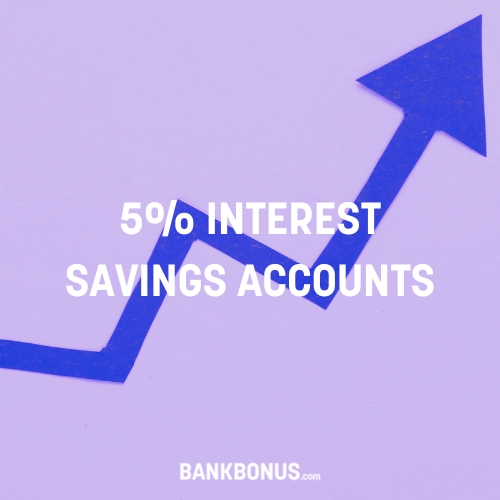Finding a 7% interest savings account is currently a stretch. The best APY for online high-yield savings accounts is closer to 5%. If you’re looking for at least a 7% return, you’re more likely to find it investing in a stock market total index fund.
However, there’s currently one checking account that pays 7% on a portion of your funds, and more accounts could spring up in the future. Read on for details on the offer and to compare some of your best alternatives.
What Does 7% Interest Mean?
When you earn 7% interest, the bank pays you 7% of the amount you deposit and keep in your savings account each month.
While several banks pay 5% interest on your entire account balance, no banks currently pay 6-7% on the full amount you deposit. Instead, the highest interest rate is usually reserved for a small portion of your balance, dropping to a mediocre rate for remaining account balances.
Before jumping at the chance to earn 7% interest, read the fine print. Determine the restrictions banks have, mainly the limit on which they’ll pay the 7% APY.
¹Annual Percentage Yield (APY) is accurate as of 1/17/2024 and subject to change at the Bank’s discretion. The minimum deposit required to open an account is $500 and a minimum balance of $0.01 is required to earn the advertised APY.Learn More:
Which Bank Offers 7% Interest Savings Accounts in the USA?
7% interest isn’t something most banks offer in the US, but one credit union, Landmark CU, pays over 7% interest on its checking account. However, there are some major requirements and stipulations to consider:
Landmark Credit Union: 7.50% up to $500
Landmark Credit Union offers various products, including checking, savings, money market accounts, and Health Savings accounts. Some of their most prominent features include:
- Online banking
- Mobile banking
- eStatements
- Home equity loans, auto loans, student loans, and personal loans
- Mobile deposits
- VISA debit card
While this may sound impressive, there are other great credit unions offering high APYs on savings accounts with fewer restrictions. This rate is subject to change at any time, however, are accurate as of April 2024.
Visit LandmarkCU.com to learn more
What’s the catch with Landmark CU’s 7% interest account?
It’s important to understand that Landmark only pays the 7.5% rate on the first $500 in your Premium Checking Account and only if you have a monthly direct deposit of at least $250 and get eStatements. Balances over $500 earn just 0.06%.
Is the Landmark CU 7% interest account worth it?
A 7% APY sounds amazing, but that only equates to $3 of interest per month on a $500 balance.
Instead, you may be better off opening a bank account with a lower interest rate and fewer restrictions at a different bank.
Most banks will apply their highest rates to a much larger portion of your savings balance, and a bank like UFB Direct doesn’t have any balance caps, so you’ll earn far more interest (currently at 5.25%) overall despite a lower APY.
Ultimately, promotional rates like the 7%+ interest from Landmark CU aren’t all they’re cracked up to be.
Learn More:
Best Alternative High-Yield Savings Accounts
While a true 7% interest savings account may be unattainable, other high-yield savings accounts exist and may be more worth it based on each bank’s unique requirements.
These high-yield savings accounts pay higher interest rates than you’ll get at your local bank, but of course, they’re always subject to change.
| Product | APY | Min Deposit |
|---|---|---|
| Western Alliance Bank High Yield Savings Premier |
5.36% APY | $0 |
| UFB Direct UFB High Yield Savings |
5.25% APY | $0 |
| Customers Bank High Yield Savings |
5.16% APY | $1 |
| EverBank Yield Pledge® Online Savings |
5.15% APY | $25 |
| Bread Financial High-Yield Savings |
5.15% APY | $100 |
| Mission Valley Bank High Yield Savings Account |
5.12% APY | $0 |
| Bask Bank Bask Interest Savings |
5.10% APY | $0 |
| BMO BMO Alto Online Savings Account |
5.10% APY | $0 |
| CIT Bank Platinum Savings |
up to 5.05% APY | $100 |
| Varo Bank Savings Account |
up to 5.00% APY | $0 |
| LendingClub Bank High-Yield Savings |
5.00% APY | $100 |
| One Finance One account |
up to 5.00% APY | $0 |
| M1 Finance M1 Savings |
up to 5.00% APY | $0 |
| Upgrade Premier Savings |
4.81% APY | $0 |
| First Mid Bank & Trust High Yield Savings Account |
4.80% APY | $0 |
Factors to Consider When Choosing a High-Interest Savings Account
As you compare high yield savings accounts, consider the factors below:
1. Interest Rates
Interest rates are one of the most important factors to consider when it comes to your savings. Pay attention to the overall APY and any requirements for earning it, such as having a minimum account balance or enrolling in e-statements.
Some banks offered tiered interest rates as well. It’s crucial to read the fine print before choosing an account.
2. Minimum or Maximum Deposits
Before choosing a high-interest-rate savings account, consider the minimum or maximum deposits allowed. First, consider the minimum opening deposit required or the minimum monthly balance. You won’t earn the highest interest rate if you can’t meet either.
You should also pay attention to the maximum amount allowed. It’s not that the banks don’t allow you to deposit more money, but they may not pay the highest interest rate advertised on the full amount of funds deposited into your account.
3. Notice Period
Last, take a moment to find out if the bank has a predetermined period regarding when they will notify you if interest rates change.
Some banks state that interest rates can change without notice, which means there’s no guarantee you’ll earn the high-interest rate long-term. Meanwhile, other banks are transparent about how long their promotional interest rates will last.
Frequently Asked Questions
Do you lose interest if you withdraw from a savings account?
When you withdraw funds from your savings account, you decrease the interest you could earn in the long run. While you won’t lose out on the interest you’ve already earned, your future interest accumulated could be lower because there’s less money in your account to earn a return on.
Do I have to declare interest earned on a savings account?
According to the IRS, you must report all interest earned on your savings account or any other bank account, for that matter. Banks aren’t required to send you a 1099-INT unless you earn $10 or more in interest, but you should keep track of the interest earned and report it on your tax returns.
Should I have more than one savings account?
If you have various financial goals, it’s a good idea to have multiple savings accounts. This makes it easier to track your progress. It might also be a good idea to have multiple accounts if you have money in a savings account that only pays the highest interest rate on a certain balance and then pays minimal interest on the rest of your balance. You could also access bank bonuses for opening multiple accounts and meeting minimum deposit requirements.
Is monthly interest better than annual?
Monthly interest compounds more frequently than annual interest, so you’ll earn more money over time. Daily compounding is the best-case scenario, and some of the best high yield savings accounts compound daily and pay out monthly. Review the terms of an individual bank account to determine how often interest is compounded.
What is meant by a 7% interest savings rate for 1 Year?
If you earn a 7% interest rate annually, you will earn $70 for every $1,000 you have saved. If it compounds monthly, you will earn $70 in the first month and $74.90 in the second month.
How do I calculate interest earned on a 7% interest savings account?
To calculate interest earned on savings, multiply the principal amount deposited by the interest rate. For example, if you deposit $1,000 and earn 7%, you’d do the following: $1,000 x .07 = $70.





Comments are closed.
Comments are closed here.